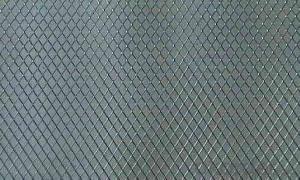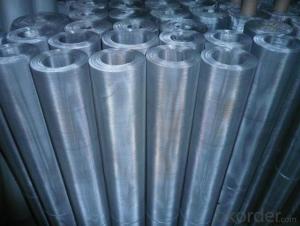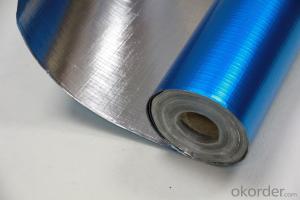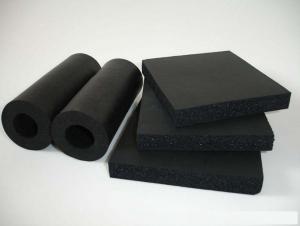Aluminum Foil Facing Electro Welded Mesh
- Loading Port:
- China Main Port
- Payment Terms:
- TT OR LC
- Min Order Qty:
- -
- Supply Capability:
- -
OKorder Service Pledge
OKorder Financial Service
You Might Also Like
Specifications
wire mesh
1. CE, ISO9001:2008
2. High Quality Low Price
3.Galvanized wire, PVC coated
4.Delivery: 10 days




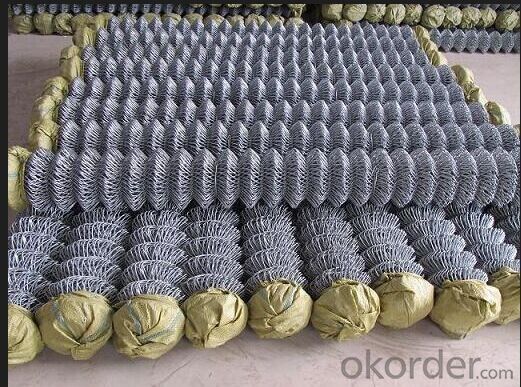

Woven wire mesh
Stainless Steel Wire Mesh:
We produce stainless steel wire mesh from first class stainless steel wire material in SUS/AISI 201 202 302 304 310 310S 316 316L 321 430 etc.
Stainless steel wire mesh with its excellent resistance against acid, alkali, heat and corrosion, find extensively uses in processing of oil, chemical, food, making wire mesh filter, also sorting and screening of solid, liquid and gas in mine, metallurgy, airspace and machine making etc.
Stainless steel wire mesh | ||||||
mesh/inch | wire diameter mm | aperture mm |
| mesh/inch | wire diameter mm | aperture mm |
2mesh | 1.80 | 10.90 | 60mesh | 0.15 | 0.273 | |
3mesh | 1.60 | 6.866 | 70mesh | 0.14 | 0.223 | |
4mesh | 1.20 | 5.15 | 80mesh | 0.12 | 0.198 | |
5mesh | 0.91 | 4.17 | 90mesh | 0.11 | 0.172 | |
6mesh | 0.80 | 3.433 | 100mesh | 0.10 | 0.154 | |
8mesh | 0.60 | 2.575 | 120mesh | 0.08 | 0.132 | |
10mesh | 0.55 | 1.990 | 140mesh | 0.07 | 0.111 | |
12mesh | 0.50 | 1.616 | 150mesh | 0.065 | 0.104 | |
14mesh | 0.45 | 1.362 | 160mesh | 0.065 | 0.094 | |
16mesh | 0.40 | 1.188 | 180mesh | 0.053 | 0.088 | |
18mesh | 0.35 | 1.060 | 200mesh | 0.053 | 0.074 | |
20mesh | 0.30 | 0.970 | 250mesh | 0.04 | 0.061 | |
26mesh | 0.28 | 0.696 | 300mesh | 0.035 | 0.049 | |
30mesh | 0.25 | 0.596 | 325mesh | 0.03 | 0.048 | |
40mesh | 0.21 | 0.425 | 350mesh | 0.03 | 0.042 | |
50mesh | 0.19 | 0.318 | 400mesh | 0.025 | 0.0385 | |
Width of Stainless Steel Wire Mesh: 0.6m-1.5m | ||||||
Welded Wire Mesh
Reinforcing Mesh Panel Description:
1. Reinforcing Mesh Panel also named Welded Steel Bar panel or Heavy welded wire mesh panel.
2. Wire diameter of Weded Steel Bar Panel: 5mm -16mm
3. The opening of Welded Steel Bar Panel: 75mm-300mm
4. Reinforcing Mesh Panel length: 1m - 12m
5. Reinforcing Mesh Panel width: 100cm-240cm
6. Reinforcing Mesh Panel, Wire profile: Smooth profile, or ribbed profiile.
7. Reinforcing Mesh Panel, type of material: Q235
8. Reinforcing Mesh Panel Standard size: 2.4m x 6m
9. Australian Standard: SL72,SL82.
- Q: This question asks for various purposes that aluminum foil facing can be used for, other than its conventional use.
- <p>Aluminum foil facing has several alternative uses. It can be used as a reflective surface to enhance the heat distribution in grilling or baking. It can also serve as a protective barrier in gardening to deter pests or as a makeshift sled for sliding on snow. Additionally, it can be used to clean stubborn stains or as a shield to protect surfaces from paint splatters during home improvement projects. Some people even use it for crafting or DIY projects due to its malleability and reflective properties.</p>
- Q: What are the advantages of using recycled aluminum foil for cooking and food storage?
- <p>Using recycled aluminum foil in cooking and food storage offers several benefits. It is environmentally friendly as it reduces waste and conserves resources. Recycled foil retains the same properties as non-recycled foil, providing excellent heat conduction and insulation, which is crucial for even cooking and maintaining food temperature. It is also cost-effective as it is generally cheaper than non-recycled foil. Moreover, it is versatile, suitable for a wide range of applications from baking to wrapping food for storage. However, it's important to ensure that the recycled foil is food-grade and meets safety standards to avoid any health risks.</p>
- Q: Is it safe and effective to use aluminum foil with a reflective side for baking purposes?
- <p>Yes, aluminum foil facing can be used for baking. The shiny side of aluminum foil is often used to cover baking dishes to prevent food from drying out, to create a steam effect, or to reflect heat for even cooking. However, it's important to avoid direct contact between the foil and the heating elements of the oven to prevent fire hazards. Always follow the manufacturer's guidelines for safe use and placement of aluminum foil in your oven.</p>
- Q: Can aluminum foil be shaped into a roasting rack?
- <p>Yes, you can create a makeshift roasting rack using aluminum foil. To do this, take two long sheets of aluminum foil and fold them back and forth to create a series of parallel ridges. These ridges will provide support for your roast while allowing air to circulate underneath. Place the folded foil on a baking sheet, spacing the ridges evenly apart to create a grid-like pattern. Your roast can then be placed on top of this foil 'rack' for cooking. This method is a simple and effective way to elevate your food for better heat distribution and crisping.</p>
- Q: This question asks for methods to store aluminum foil to prevent damage and rusting.
- <p>Aluminum foil is resistant to rusting, but it can still be damaged if not stored properly. To store aluminum foil, keep it in a cool, dry place away from direct sunlight. Use an airtight container or a resealable plastic bag to protect it from moisture and air, which can cause it to oxidize and lose its shine. Avoid stacking heavy items on top of it, as this can cause dents and tears. If you have a large amount, consider using a foil storage box with compartments to keep it organized and protected.</p>
- Q: This question asks for methods to prevent metal flakes from aluminum foil from getting into the eyes or mouth while using it.
- <p>To avoid getting metal flakes from aluminum foil into your eyes or mouth, handle the foil carefully with clean, dry hands. Avoid using foil that is crumpled or damaged, as it can release more flakes. When cutting foil, use a sharp knife to minimize the creation of small particles. Keep foil away from your face and eyes while handling, and consider wearing safety glasses if you are concerned about eye safety. Wash your hands thoroughly after handling aluminum foil to remove any residual flakes before touching your face or eating.</p>
- Q: What are the potential health risks associated with the use of aluminum foil facing?
- <p>There are no significant health risks associated with the use of aluminum foil facing in everyday cooking and food storage. While aluminum is a common element and can be found naturally in many foods and water sources, the amount that might leach from foil into food is minimal and not considered harmful. However, it's always best to avoid wrapping acidic or highly salty foods in aluminum foil, as this might increase the potential for aluminum to leach into the food. For most people, the small amounts of aluminum that could come into contact with food from foil are not a health concern.</p>
- Q: The user is asking if it's possible to use aluminum foil with a shiny side facing outward to create a sandwich roll.
- <p>Yes, you can use aluminum foil to make a sandwich roll, but it's not recommended to use the shiny side facing outward. The dull side of the foil is typically used for food contact because it's less likely to transfer any potential residues or chemicals to the food. The shiny side may have a coating that isn't safe for direct food contact. Always ensure that the foil is food-safe and use it according to the manufacturer's instructions.</p>
- Q: Explain the differences between aluminum foil facing and plastic wrap when it comes to storing food.
- <p>Aluminum foil facing and plastic wrap are both used for food storage, but they have distinct properties. Aluminum foil facing is a moisture-resistant barrier that reflects heat, making it ideal for cooking and reheating food in the oven or microwave. It's also good for sealing in freshness and preventing freezer burn. Plastic wrap, on the other hand, is a clingy film that tightly seals around food to keep it fresh. It's transparent, allowing you to see the contents, and is useful for covering dishes and bowls. However, it's not heat resistant and can melt or release harmful chemicals when heated, so it's not suitable for cooking or reheating food.</p>
- Q: Can aluminum foil be used as a surface for making pizza crust?
- <p>Yes, you can use aluminum foil facing to make a pizza crust. It's a convenient and non-stick surface that allows the crust to bake evenly and prevents it from sticking. Simply prepare your pizza dough and place it on a piece of aluminum foil sprayed with cooking oil or lined with a silicone mat. Bake according to your pizza recipe, and the aluminum foil will help create a crispy crust.</p>
Send your message to us
Aluminum Foil Facing Electro Welded Mesh
- Loading Port:
- China Main Port
- Payment Terms:
- TT OR LC
- Min Order Qty:
- -
- Supply Capability:
- -
OKorder Service Pledge
OKorder Financial Service
Similar products
Hot products
Hot Searches
Related keywords

















